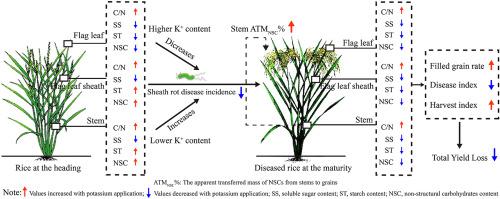当前位置:
X-MOL 学术
›
Crop Prot.
›
论文详情
Our official English website, www.x-mol.net, welcomes your
feedback! (Note: you will need to create a separate account there.)
Applying potassium fertilizer improves sheath rot disease tolerance and decreases grain yield loss in rice (Oryza sativa L.)
Crop Protection ( IF 2.5 ) Pub Date : 2021-01-01 , DOI: 10.1016/j.cropro.2020.105392 Jianglin Zhang , Wenfeng Hou , Tao Ren , Rihuan Cong , Zhuqing Zhao , Jianwei Lu , Xiaokun Li
Crop Protection ( IF 2.5 ) Pub Date : 2021-01-01 , DOI: 10.1016/j.cropro.2020.105392 Jianglin Zhang , Wenfeng Hou , Tao Ren , Rihuan Cong , Zhuqing Zhao , Jianwei Lu , Xiaokun Li

|
Abstract Sheath rot disease (ShR) is a new threat in rice production, causing yield losses of 10–85%. Potassium (K) plays an important role in improving rice tolerance to disease and ensuring yield stability. Two-year field studies with four K application rates were conducted to investigate the impacts of K application on ShR disease incidence and yield loss caused by ShR. The results showed that K application significantly decreased the ShR disease incidence by 20.0–72.1% and 37.8–89.9% in the 2017 and 2018 rice growing seasons, respectively. Similarly, K application profoundly alleviated the severity of ShR. Therefore, the total yield loss rate (TYLR) considerably decreased with increasing K application rates. Compared with the zero-K application, K application decreased the TYLR by averages of 59.3% and 74.4% in 2017 and 2018, respectively. The filled-grain rate decrease contributed the most to the TYLR in ShR disease. In addition, K starvation increased the C/N ratio of the flag leaf sheath (FLS), which was negatively correlated with the ShR disease index (DI). In contrast, soluble sugar (SS) accumulation in the FLS was positively correlated with the DI. K application significantly increased the apparent transferred mass of non-structural carbohydrates (NSCs) from stems to grains (ATMNSC). Moreover, the stem ATMNSC of diseased plants contributed more to the final grain yield than did that of healthy plants. During ShR disease, K application significantly alleviated the decrease in the filled-grain rate and harvest index by enhancing the stem ATMNSC, according to an exponential equation relationship between the stem ATMNSC and the filled-grain rate of diseased rice. Maintaining the stem K concentration in the range of 1.53–1.74% at the heading stage could increase the stem ATMNSC to mitigate the TYLR. These results emphasize the importance of K in rice to improve the potential for alleviating ShR disease.
中文翻译:

施用钾肥可提高水稻(Oryza sativa L.)的鞘腐病抗性并减少谷物产量损失
摘要 鞘腐病(ShR)是水稻生产中的一个新威胁,造成 10-85% 的产量损失。钾(K)在提高水稻抗病性和确保产量稳定方面起着重要作用。进行了为期两年的田间研究,以四种钾肥施用量施用钾肥对 ShR 引起的 ShR 病害发生率和产量损失的影响。结果表明,施钾使 2017 年和 2018 年水稻生长季的 ShR 病害发生率分别显着降低了 20.0-72.1% 和 37.8-89.9%。同样,钾的应用大大减轻了 ShR 的严重程度。因此,总产量损失率(TYLR)随着钾肥施用量的增加而显着降低。与零K应用相比,K应用在2017年和2018年分别使TYLR平均下降了59.3%和74.4%。满粒率下降对 ShR 病害中的 TYLR 贡献最大。此外,K饥饿增加了旗叶鞘(FLS)的C/N比,与ShR疾病指数(DI)呈负相关。相比之下,FLS 中可溶性糖 (SS) 的积累与 DI 呈正相关。施钾显着增加了从茎到谷粒 (ATMNSC) 的非结构碳水化合物 (NSC) 的表观转移质量。此外,与健康植物相比,患病植物的茎 ATMNSC 对最终谷物产量的贡献更大。根据茎ATMNSC与病稻的饱满粒率之间的指数方程关系,施钾通过增强茎ATMNSC显着缓解了饱满粒率和收获指数的下降。在抽穗期将茎 K 浓度保持在 1.53-1.74% 的范围内可以增加茎 ATMNSC 以减轻 TYLR。这些结果强调了水稻中钾的重要性,以提高减轻 ShR 病害的潜力。
更新日期:2021-01-01
中文翻译:

施用钾肥可提高水稻(Oryza sativa L.)的鞘腐病抗性并减少谷物产量损失
摘要 鞘腐病(ShR)是水稻生产中的一个新威胁,造成 10-85% 的产量损失。钾(K)在提高水稻抗病性和确保产量稳定方面起着重要作用。进行了为期两年的田间研究,以四种钾肥施用量施用钾肥对 ShR 引起的 ShR 病害发生率和产量损失的影响。结果表明,施钾使 2017 年和 2018 年水稻生长季的 ShR 病害发生率分别显着降低了 20.0-72.1% 和 37.8-89.9%。同样,钾的应用大大减轻了 ShR 的严重程度。因此,总产量损失率(TYLR)随着钾肥施用量的增加而显着降低。与零K应用相比,K应用在2017年和2018年分别使TYLR平均下降了59.3%和74.4%。满粒率下降对 ShR 病害中的 TYLR 贡献最大。此外,K饥饿增加了旗叶鞘(FLS)的C/N比,与ShR疾病指数(DI)呈负相关。相比之下,FLS 中可溶性糖 (SS) 的积累与 DI 呈正相关。施钾显着增加了从茎到谷粒 (ATMNSC) 的非结构碳水化合物 (NSC) 的表观转移质量。此外,与健康植物相比,患病植物的茎 ATMNSC 对最终谷物产量的贡献更大。根据茎ATMNSC与病稻的饱满粒率之间的指数方程关系,施钾通过增强茎ATMNSC显着缓解了饱满粒率和收获指数的下降。在抽穗期将茎 K 浓度保持在 1.53-1.74% 的范围内可以增加茎 ATMNSC 以减轻 TYLR。这些结果强调了水稻中钾的重要性,以提高减轻 ShR 病害的潜力。











































 京公网安备 11010802027423号
京公网安备 11010802027423号